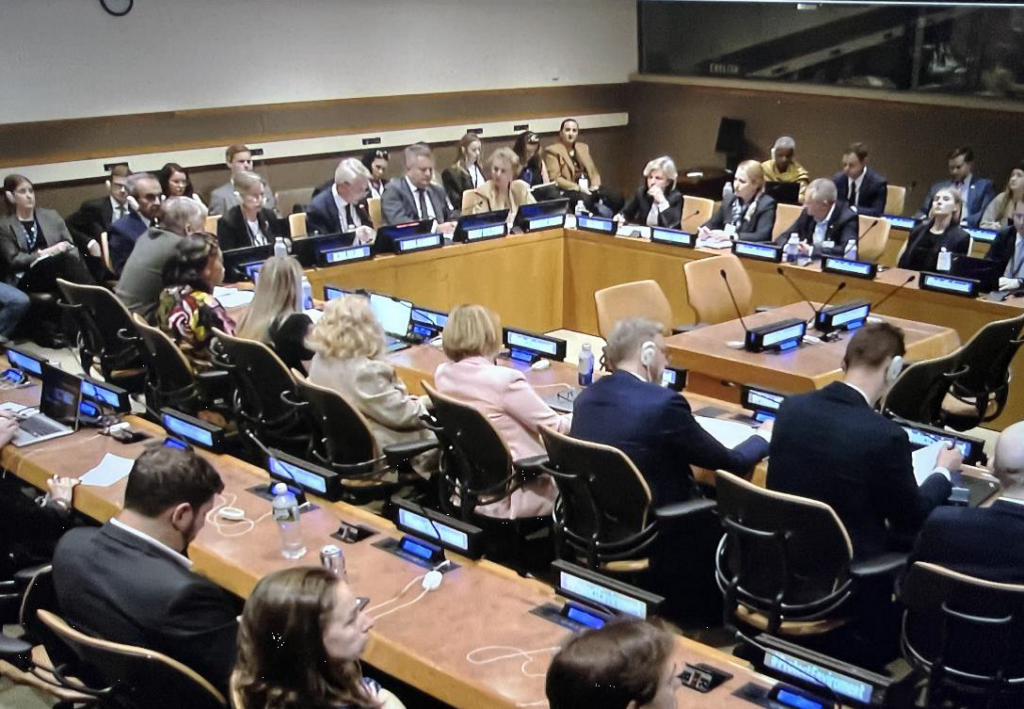M.Z. Zgurovsky
Wars have always been devastating for humanity, yet their impact on nature often remained unnoticed. Air, water, and soil pollution, deforestation, and ecosystem destruction are invisible consequences that threaten our planet. Today, we are faced with the question: can humanity halt this destructive cycle and preserve the natural balance?
This issue was the focus of the UN seminar titled “Environmental Security in War and Armed Conflict,” held on November 6, 2024, in New York [1]. Seminar participants stated that Ukraine, as a country experiencing massive military aggression, faces tremendous challenges in environmental security. Landmines, destroyed infrastructure, fires in protected areas, and water pollution demand immediate measures to mitigate the consequences.
Armed conflicts cause irreversible damage to ecosystems. According to the Uppsala Conflict Data Program (UCDP) [2] and the Heidelberg Institute for International Conflict Research (HIIK) [3], the number of wars worldwide has increased from 10 to 37 over the last 25 years, while the number of countries involved in conflicts has grown from 30 to 55.
Between 2000 and 2024, armed conflicts inflicted significant harm on the planet’s ecology, causing widespread damage from the destruction of natural ecosystems to exacerbating the climate crisis [4-10]. The scale of their impact extends far beyond combat zones, affecting global environmental and social systems.

One of the most severe issues has been the destruction of forest ecosystems (scored 9 out of 10 on the importance scale), affecting over 20 million hectares of forests worldwide [4,5]. Of these, 8.2 million hectares were directly destroyed by military actions. Forests in Africa, Syria, Ukraine, Southeast Asia, and Latin America have suffered from shelling, fires, and illegal logging caused by armed conflicts. These losses significantly reduce the planet’s ability to absorb carbon dioxide, intensify climate risks, and complicate the recovery of habitats for many species.
Biodiversity loss (importance rating: 9) has become another catastrophic consequence [4,6,7]. For example, in Africa, poaching and military activities have led to the destruction of up to 70% of rhinos and 60% of elephants. In Ukraine, over 3 million hectares of natural areas have been lost, while in the Middle East, about 50% of reserves have suffered significant damage. Populations of many species in conflict zones have declined by 20–50%, undermining ecosystem resilience and overall ecological stability.
Landmines (importance rating: 8) are another serious issue [9]. The total area of mined lands is estimated at 200–250 thousand square kilometers, including over 156 thousand square kilometers in Ukraine. These areas remain unsuitable for agriculture, ecosystem restoration, or safe human habitation. Landmines also create long-term barriers to economic and environmental recovery.
Damage to agricultural lands (importance rating: 8) has led to the degradation of over 260 thousand square kilometers of farmland in countries such as Syria, Yemen, and Ukraine [6]. More than 30% of productive lands in these regions have lost their fertility, causing reduced crop yields, worsening food crises, and deepening social conflicts, especially in regions heavily reliant on agriculture.
Massive fires and toxic emissions (importance rating: 7) caused by armed conflicts have significantly polluted the atmosphere [4,8]. For instance, the war in Ukraine was accompanied by large-scale industrial fires in 2022–2023, releasing toxic substances into the air. Such events deteriorate air quality, pose serious health risks, and cause irreparable environmental damage.
Water pollution during military actions (importance rating: 7) has become a persistent and challenging problem. By the end of 2024, the total volume of polluted water reached 19–34 billion cubic meters, and over 40% of people in conflict zones lost access to clean drinking water [10]. In countries such as Iraq, Syria, and Yemen, this has led to significant humanitarian and environmental crises, requiring substantial investments to restore water resources.
Carbon dioxide emissions (importance rating: 6) associated with armed conflicts amounted to 1005.5–1155 million tons of CO₂ during the review period [10]. Conflicts like the Iraq War (2003–2011) and the war in Ukraine (2014–2024) left a significant carbon footprint. This not only exacerbates global climate change but also complicates international efforts to reduce emissions.
All the factors described highlight the extensive environmental damage caused by military conflicts. Each factor contributes to the overall destruction of the natural environment, as reflected in their importance ratings on a scale of 1 to 10. Conceptually, armed conflicts deepen the climate crisis, degrade ecosystems, reduce biodiversity, and exacerbate humanitarian problems. Restoring these ecosystems requires coordinated international efforts.
It is crucial to implement global programs for reforestation, soil and water resource restoration, and financing the recovery of affected areas. Additionally, mechanisms to reduce the military carbon footprint and monitor the environmental impacts of armed conflicts must be developed.
In scientific research and practice, various approaches are used to integrate environmental impacts into comprehensive assessments. General (universal) indices for assessing the environmental damage caused by military conflicts include:
- Environmental Degradation Index (EDI) [11]: Combines quantitative indicators of forest loss, biodiversity decline, landmining, agricultural land damage, fires, toxic emissions, and water pollution into a single scale.
- Ecological Footprint (EF) [12]: Accounts for CO₂ emissions, resource depletion, and ecosystem degradation.
- Ecosystem Resilience Index (ERI) [13]: Reflects the loss of ecosystems’ ability to perform their functions.
Restoring the natural balance requires a global commitment to protecting nature and mitigating the environmental consequences of armed conflicts. Only through collective action can we ensure a sustainable future for the planet.
Using the data [4-10], calculations of the mentioned indices were conducted. The Environmental Degradation Index (EDI), with a value of 9.48, demonstrates an unprecedented level of environmental destruction. This includes soil, water, and air pollution, biodiversity loss, landscape destruction, and disruption of ecosystem functions. Such a high value indicates systemic degradation affecting not only local territories but also global ecological stability.
Equally alarming is the Ecological Footprint (EF), estimated at 8,695,000 hectares. This area represents the scale of natural resources required to compensate for the inflicted damage. The destruction of agricultural lands, deforestation, landmining, and environmental pollution have rendered vast areas ecologically unviable. The impact of these losses extends beyond ecosystems, affecting economic and social spheres and creating a long-term burden for future generations.

Another concerning metric is the Ecosystem Resilience Index (ERI), which stands at only 0.09. This critically low value reflects a significant loss of the affected areas’ ability to recover. The disruption of natural climate regulation, water purification, and biodiversity loss underscores the severity of the problem. Ecosystems, which typically serve as the foundation of ecological balance, are reaching a state where their functions become almost irreparable.
Based on the conducted research, the following conclusions can be drawn:
1. Since the beginning of the 21st century, humanity has witnessed an unprecedented level of the impact of armed conflicts on the planet’s natural systems. The number of wars globally has increased from 10 at the beginning of the century to 37 as of 2024, while their duration has extended from 3–5 years to 10–15 years. The number of countries involved in military actions has risen from 30 to 55, causing catastrophic changes in ecosystems. One of the most critical consequences is the destruction of natural systems, particularly forests in conflict regions such as Africa, the Middle East, and Eastern Europe (Ukraine). Forests, as vital carbon reservoirs, are being lost at a rate that significantly exceeds the natural recovery capacity, undermining global ecological stability and exacerbating climate crises.
2. The destruction of natural systems creates an “ecosystem debt,” where even the cessation of harmful activities does not ensure automatic recovery. For instance, degraded soils and species extinction lead to the loss of ecosystem services such as climate regulation, pollination, and water purification. The combination of military actions, climate change, urbanization, and industrial activities significantly exceeds the planet’s natural self-regulation capacity. This pressure poses real threats to sustainable human development.
3. Environmental indices, such as the Environmental Degradation Index (EDI), Ecological Footprint (EF), and Ecosystem Resilience Index (ERI), provide quantitative measures of these impacts and highlight trends that threaten humanity’s future:
- The Environmental Degradation Index (EDI = 9.48) reflects the high degree of impact of armed conflicts on natural systems. Key factors include deforestation, biodiversity loss, water pollution, and CO₂ emissions. These processes are global in scale, destroying critical ecosystem functions that ensure climate stability, food security, and quality of life.
- The total ecological footprint of conflicts is estimated at EF = 8,695,000 hectares of lost natural territory. This area includes degraded forests, mined lands, and damaged agricultural areas, pointing to a vast resource base that no longer performs its natural functions.
- The low Ecosystem Resilience Index (ERI = 0.09) demonstrates the critical state of ecosystems losing their ability to recover. Deforestation and biodiversity reduction create conditions for long-term natural system degradation.
4. The planet’s ecological reserve is not limitless. Ecosystems have critical thresholds, beyond which irreversible degradation begins. The loss of 50% of the planet’s forests could disrupt the carbon cycle, and the extinction of 50–70% of key species could endanger food chains. Current trends indicate that the planet is already approaching these limits. Significant losses of forests, biodiversity, and soil degradation create risks of irreversible changes to natural systems. If current trends persist, serious consequences could manifest by 2050, validating the hypothesis of “The conflict of the 21st century.” This includes mass migrations, food shortages, and more extensive armed conflicts over resources.
5. If the growth of armed conflicts continues at a linear rate [2,3], the following projections for the future may be expected:
- Between 2025 and 2030, the negative impact of armed conflicts on vulnerable regions worldwide may continue to escalate.
- From 2030 to 2040, critical depletion of soil and water resources is expected.
- Between 2040 and 2050, widespread ecosystem degradation may begin, impacting human life globally.
6. It is necessary to establish international mechanisms for protecting ecosystems in conflict zones, fund projects for restoring forests, biodiversity, and degraded lands, and develop indices and models for predicting critical thresholds. Emphasizing peacekeeping activities that minimize the environmental impact of conflicts is also essential. Nature is not limitless, and delaying action will lead to irreversible consequences for humanity. The planet’s ecological reserve is already on the brink of depletion, and immediate global efforts are needed to prevent environmental catastrophe. Armed conflicts have become a powerful catalyst for destroying natural systems, and only through international cooperation focused on preventing their spread can humanity ensure its future.
REFERENCES
- https://webtv.un.org/en/asset/k17/k17k7fakgw
- https://ucdp.uu.se/year/2023.
- Heidelberg Institute for International Conflict Research. Datasets. 2023. https://hiik.de/data-and-maps/datasets/?lang=en
- (UNEP). 2024. https://www.unep.org/
- International Peace Research Institute (SIPRI). 2025. https://www.sipri.org/
- of the United Nations (FAO). 2024. https://www.fao.org/home/en/
- orldwildlife (WWF). Our work in action. 2025. https://www.worldwildlife.org/
- Global Fire Emissions Database (GFED). Related datasets and older GFED versions. 2025. https://www.globalfiredata.org/related.html
- ICBLCMC. Protecting lives (ICBL). 2025. https://www.icblcmc.org/
- https://www.unicef.org/
- https://www.footprintnetwork.org/resources/data/?utm_source=chatgpt.com
- Angeler, D. G., & Allen, C. R. (2016). “Quantifying resilience.” Journal of Applied Ecology, 53(3), 617–624.
